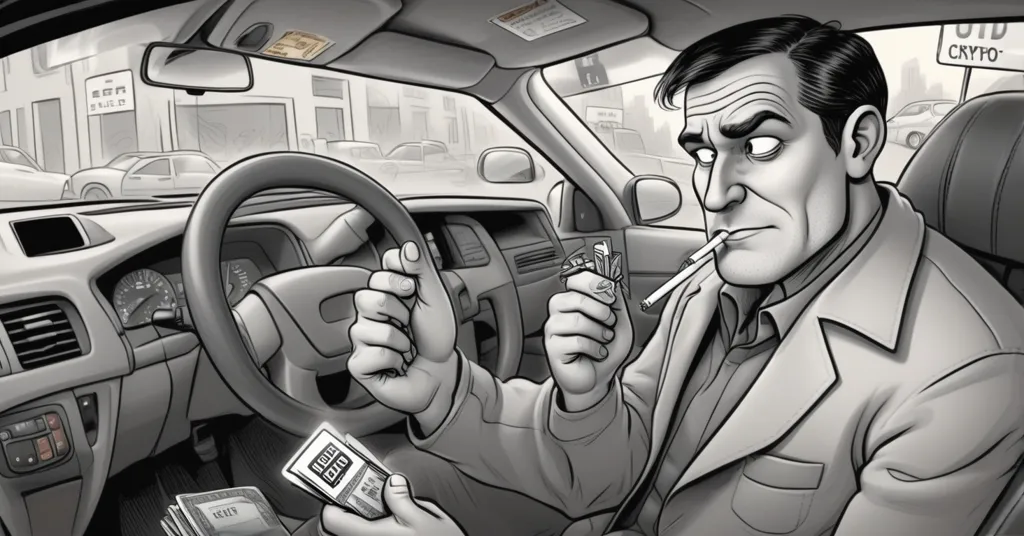American Tourist Loses $123k in Crypto to Fake Uber Driver in London: A Global Scam Surge

London Uber Driver Scams American Tourist Out of $123k in Crypto: A Rising Trend in Digital Asset Theft
Imagine stepping into what you think is an Uber after a night out, only to wake up robbed of your digital fortune. Jacob Irwin-Cline, a 30-year-old American tourist, experienced this nightmare firsthand in London, losing $123,000 in cryptocurrency to a man posing as an Uber driver.
- American tourist drugged and robbed in London
- Fake Uber driver uses sedative-laced cigarette
- Part of a global trend in crypto-related crimes
The Incident
After enjoying a night out in Soho, Jacob Irwin-Cline called an Uber to return to his hostel. Instead of the expected ride, he entered a vehicle driven by a man who introduced himself as “Mohammed.” This impostor offered Cline a cigarette, which was laced with scopolamine—a drug that can cause unconsciousness. After a few puffs, Cline blacked out, only to wake up later on the street without his phone, which contained access to his cryptocurrency wallets.
A cryptocurrency wallet is a digital tool used to store and manage cryptocurrencies, much like a physical wallet holds cash. For Cline, losing his phone meant losing the keys to his digital assets, resulting in a significant financial loss.
A Broader Trend
Cline’s harrowing experience is not isolated but part of a disturbing global trend in crypto-related crimes. The FBI’s 2023 Cryptocurrency Fraud Report highlights a 45% increase in losses due to cryptocurrency fraud, totaling over $5.6 billion. This surge in fraud underscores the growing threat to individuals holding digital assets.
Similar incidents have been reported worldwide. In France, the father of a crypto exchange founder was kidnapped, and there was an attempted abduction of Paymium CEO Pierre Noizat’s daughter and grandson. In the U.S., Florida teens kidnapped a man in Las Vegas, forcing him to transfer millions in cryptocurrency. These cases reflect a broader insecurity faced by crypto entrepreneurs and holders globally, with France alone accounting for 26% of global attacks related to cryptocurrencies.
Law Enforcement Efforts
The FBI has established the Virtual Assets Unit (VAU) to combat these crimes, showing a dedicated effort to protect cryptocurrency users. They encourage victims to report incidents to the Internet Crime Complaint Center (IC3) and provide guidance on what information to include for effective investigations. The French authorities are also cracking down on these criminal networks, with arrests made in connection to the kidnappings.
Law enforcement agencies are increasingly using advanced technologies like blockchain analysis to track and recover stolen cryptocurrency, adding a layer of sophistication to their efforts. The FBI’s cybercrime unit has had varying success in recovering stolen digital assets.
Navigating the Crypto World
The potential of blockchain and cryptocurrencies to revolutionize finance is undeniable. These technologies promise greater decentralization—a system where transactions are managed by a network of users rather than a central authority—and freedom, disrupting the status quo. Yet, as we champion these ideals, it’s crucial to acknowledge the risks involved.
Effective accelerationism, the drive to push forward with innovation, remains a guiding force in the crypto community. However, as the story of Jacob Irwin-Cline and others illustrates, vigilance and robust security measures are essential to navigate this brave new world responsibly.
How to Protect Your Crypto Assets
Given the rising trend of crypto-related crimes, securing your digital assets is more important than ever. Here are some practical tips:
- Use Hardware Wallets: Store your cryptocurrencies in hardware wallets, which are physical devices that keep your private keys offline, making them less vulnerable to hacking.
- Enable Two-Factor Authentication: Add an extra layer of security to your accounts by requiring a second form of verification, such as a text message or an authentication app.
- Avoid Public Wi-Fi: Public networks can be insecure; refrain from accessing your crypto wallets on them.
- Be Vigilant: Be cautious of unsolicited offers and verify the legitimacy of any investment opportunities. Remember, if it sounds too good to be true, it probably is.
Turns out, the only thing more dangerous than a London cabbie’s driving is a fake Uber driver’s cigarette. But with the right precautions, you can keep your digital assets safe from such scams.
Key Takeaways and Questions
- What happened to Jacob Irwin-Cline in London?
Jacob Irwin-Cline was drugged and robbed of $123,000 in cryptocurrency by a man posing as an Uber driver in London.
- How did the perpetrator gain Cline’s trust?
The perpetrator, who called himself “Mohammed,” flagged Cline down using the name saved in the Uber app and appeared friendly, which helped gain Cline’s trust.
- What method was used to drug Cline?
Cline was offered a cigarette laced with scopolamine, a drug that can cause unconsciousness, leading him to pass out.
- What was the outcome for Cline after the incident?
Cline woke up on the street without his phone, which held access to his crypto wallets, and confirmed a loss of $123,000. He contacted the FBI’s cybercrime unit but is not optimistic about recovering the funds.
- Is this incident part of a larger trend?
Yes, the incident is part of a troubling trend of crypto-related crimes targeting individuals with substantial digital assets, with similar incidents reported in France and the U.S.
- What other crypto-related crimes were mentioned?
Other incidents mentioned include the kidnapping of a crypto exchange founder’s father in France, an attempted abduction of Paymium CEO Pierre Noizat’s daughter and grandson in Paris, and a kidnapping by Florida teens in Las Vegas that resulted in a forced transfer of millions in cryptocurrency.
In the world of crypto, challenges are just stepping stones to innovation. As we push the boundaries of what’s possible, staying informed and cautious is key. Remember, it’s not just about the highs—it’s about navigating the lows with resilience and smarts.



